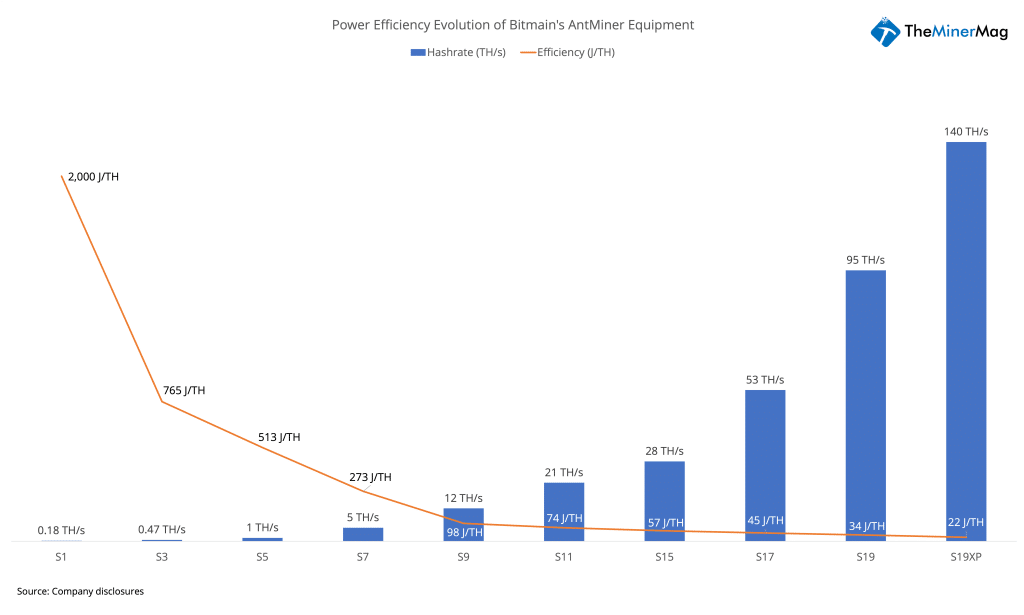Bitcoin mining is the most fundamental activity that secures network transactions through the hard work done by miners, the actual machines plugged into the network, and the software inside that gives them instructions.
The hard work they do is hashing the SHA-256 algorithm to generate a random output that fits certain criteria so that a winner can produce the next block to keep the transactional records intact.
Hardware
For a few years after bitcoin’s genesis block, general-purpose computing chips like core processing units (CPUs) or graphic processing units (GPUs) for regular computers were used to mine bitcoin given their capability of doing the SHA-256 algorithm.
But as the mining difficulty jumped up with more people drawn to the game, it became harder to mine with regular computer chips. Around 2013, Canaan Creative designed and launched the first bitcoin ASIC miner to the market. Then the industry was forever changed because ASIC miners are way more powerful than GPUs and CPUs.
From start to finish, a bitcoin ASIC miner will go through chip design, tape-out, mass production, and assembly line, before reaching final delivery.
Because a bitcoin ASIC miner is for the purpose of doing the SHA-256 algorithm only, it requires hardware expertise in optimizing a circuit design in order to maximize the power efficiency of the chips inside so that they can compute the most hashes while using the least amount of energy.
Tape-out is a step where a bitcoin ASIC chip design company approaches a foundry fabrication factory to test out whether its ASIC design can deliver the expected hashrate, power consumption, and efficiency.
Tape-out is a critical step because only with a successful tape-out, a chip design can materialize from theory to mass production and move towards assembly lines with other components before a full miner gets shipped to customers.
The diagram below shows the relationship between major foundry fabrication factories and bitcoin ASIC chip design and manufacturing companies.

Bitmain, MicroBT, and Canaan are the largest three bitcoin mining chip design and miner manufacturing companies in the world and they are all headquartered in China.
Following the 2021 crypto market bull run, U.S chip giant Intel announced its entry into the bitcoin mining chip design business and revealed its first two generations of bitcoin ASIC chips. But there is a notable difference in terms of the business model between Intel and industry incumbents.
Here’s the how: Intel intends to sell bitcoin mining ASIC chips only, instead of the eventual miner machine. Because a full bitcoin ASIC miner contains hundreds of ASIC chips, it takes a carefully designed system to ensure the efficiency of all the chips combined on hash boards inside a miner is as good as that of each chip individually.
In the case of Intel, whoever is interested in buying the chips needs to find a good system designer and manufacturer, known as an original design manufacturer (ODM), to make the eventual product.
Bitmain, MicroBT, and Canaan, however, are both chip designers and miner manufacturers so they use in-house system designs to turn hundreds of chips into a fully assembled mining machine and then deliver it to their customers.
That also helps explain why Intel chooses to charge a fixed price for its bitcoin mining ASIC chips while all other bitcoin miner manufacturers quote their products based on bitcoin’s price volatility.
But regardless of manufacturing business models, one thing certain is that the power efficiency of bitcoin ASIC chips and miners over the past decade has significantly improved.
The chart below uses Bitmain as an example given its market dominance. It captures the hashrate and the corresponding power efficiency of each generation of Bitmain’s ASIC miners. It shows that the power it takes for producing 1 TH/s of hashrate on the SHA-256 algorithm has decreased from 2,000 watts in 2013 to less than 30 watts in 2022.
As bitcoin’s network hashrate continues to rise, the power consumption growth of the network will only be flatter and flatter over time.

Software
If a piece of mining hardware is a strong body lifting weights in a gym, mining software is the spirit and soul that guides the body to do what it is meant to do.
Mining software includes operating systems and firmware. Simply plugging your equipment into a socket and turning it on doesn’t get you bitcoin. One needs an OS as an interface to connect the hardware with the bitcoin network.
During the process to interact with the network, firmware is what it takes to adjust and monitor various parameters of a miner, such as the frequency and the voltage that goes through the chips, the cube feet per minute of the fans for air cooling, the ambient temperature, and noise levels, etc.
Manufacturers typically deliver miners with stock firmware, which allows you to operate the machines within the parameters that the manufacturers see fit.
However, because manufacturers want to play safe, they advertise miners with a standard hashrate specification. The reality is that there is always margin room for higher hashrate performance but manufacturers usually will not tell you how much the margin is.
That room creates the opportunity for third-party firmware developers to make customized software that can get the most juice out of each miner. That is what makes overclocking, underclocking as well as immersion cooling techniques possible in bitcoin mining.


